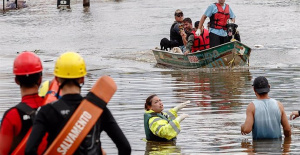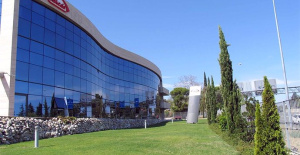The band maintained in 2000 "great structural stability" and the dome was aware of the devices
MADRID, 28 Nov. (EUROPA PRESS) -
The Civil Guard includes in a report prepared for the National Court a detailed analysis of the terrorist activity of the terrorist group ETA between 1994 and 2004: it had approximately 1,000 militants and carried out 480 terrorist actions with a total of 101 fatalities .
These data appear in the report prepared by the Civil Guard within the framework of the investigation that is being followed in the National Court to determine which members of the leadership were acting as such when the "opportune orders" were given to kill the Supreme Court magistrate Francisco Querol and two other people on October 30, 2000 in Madrid.
This investigation began in the Central Court of Instruction number 5 as a result of the complaint filed by Miguel Ángel Rodríguez Arias, a lawyer for the Dignity and Justice association. Now, in more than 300 pages, the agents, in addition to reviewing the activity of each of the ETA leaders at that time, analyze in detail the situation and activity of the band.
Thus, for example, it explains that, of these 480 actions --among which are the attack on former Prime Minister José María Aznar or the kidnapping of José Antonio Ortega Lara--, 34 took place in Madrid with the result of 24 fatalities. .
Intelligence agents indicate that in October 2000, the year in which the attack on Judge Querol was perpetrated, ETA was made up of approximately 1,000 militants. To arrive at this figure, the Civil Guard has used internal documents of the band called 'H-211-Akta', 'H-211-Egitura' and 'H211-Ondorioak' --referring to minutes of the Executive Committee ( Zuba)--, which were seized in 2002 from members of the organization in different police operations carried out in France.
It can be deduced from them that this number of militants, collected in internal records of November 2002, also included those who were inmates in prisons.
The Civil Guard considers that at the time the attack against the judge took place, "the terrorist organization ETA maintained great structural stability both in its lines of action and in the number of members that made up its different apparatuses." For this reason, he argues, the figure for the number of members presented at the November 2002 meeting was "very close to that at the time of the aforementioned terrorist attack."
Regarding this stability in the structure, the report asserts that the executive committee of the band "had not undergone significant changes from 1999 to September 2002", at which time the top officials of the 'military apparatus' were arrested. ', Juan Antonio Olarra Guridi and Ainhoa Mugica Goñi.
In addition, the agents enter to explain that the terrorist band was mainly divided into three apparatuses: the military -'Otsagi'-, the logistical -'Lohi'-; and the political apparatus -'Poltsa'-.
They remember the first that its main functions were the recruitment of new members who would become part of the structure of the organization; give training courses focused on learning the use of weapons and explosives as well as the dissemination of the ideological component; prepare information on the various targets to attack; and carry out terrorist actions.
Regarding the logistics apparatus - to which they dedicate an extensive section - they point out that it had "its own functions based on the acquisition of material, falsification of documentation and registration plates".
As for the political apparatus, they point out that it was dedicated to the management of the economy of the terrorist organization, "including those income from extortion." "It was also in charge of the management of the group of prisoners "through a structure called 'Halboka', of the development of those infrastructures prepared to welcome the fleeing members, the creation of propaganda and international cooperation." They explain that this apparatus had at least with up to seven sub-appliances.
The report highlights that among the different minutes documents confiscated from the ETA leadership at the time included "information about the number of members framed in each of the 'apparatus'. What's more, it added to this count "all those who are prisoners in jails, referring to them with the term 'Bahituta'".
This puts black on white that ETA's 'executive committee' was aware of each device of the band, and that for this it "held periodic meetings, usually bimonthly, in which the most relevant aspects for the organization were discussed. terrorist".
This periodicity is evident in the document 'H-211-Egitura' since it contains an accounting balance which analyzes the number of members that made up the different ETA apparatuses and sub-aparatuses in the months of April, July, September and November 2002.
In the report, the agents also echo an internal database of the band, which is called 'DGZ' --Data Gune Zentrala, Central Data Base in Spanish--, and which was located by the French police in the police operation that led to the arrest of the leader Francisco Javier López Peña in Bordeaux (France) in May 2008.
In that database, which was provided to the Information Headquarters of the Civil Guard, there were specific files on possible targets. The leadership of the gang, depending on the type of 'front' against which to materialize attacks, "was nurturing and updating it".
"The objective of the 'DGZ' base would be none other than to collect all the information in the Organization's possession on potential targets to be subsequently used depending on the needs that the management deems appropriate," says the Civil Guard report.
In fact, this updating of the database, says the Civil Guard, is reflected in the case of the murder of judge Querol because they estimate that once they carried out the attack against him in October 2000, "those in charge of managing the database of objectives of ETA would have updated the particular file that appeared on it (...) with the words 'ekintza' (terrorist action) and 'zendu' (dead).

 Exploring Cardano: Inner Workings and Advantages of this Cryptocurrency
Exploring Cardano: Inner Workings and Advantages of this Cryptocurrency Seville.- Economy.- Innova.- STSA inaugurates its new painting and sealing hangar in San Pablo, for 18 million
Seville.- Economy.- Innova.- STSA inaugurates its new painting and sealing hangar in San Pablo, for 18 million Innova.- More than 300 volunteers join the Andalucía Compromiso Digital network in one month to facilitate access to ICT
Innova.- More than 300 volunteers join the Andalucía Compromiso Digital network in one month to facilitate access to ICT Innova.-AMP.- Ayesa acquires 51% of Sadiel, which will create new technological engineering products and expand markets
Innova.-AMP.- Ayesa acquires 51% of Sadiel, which will create new technological engineering products and expand markets Death toll rises to 107 from floods caused by heavy rains in southern Brazil
Death toll rises to 107 from floods caused by heavy rains in southern Brazil BBVA is willing to assume the possible reputational risk if the takeover bid for Sabadell does not go ahead
BBVA is willing to assume the possible reputational risk if the takeover bid for Sabadell does not go ahead Takeda earns 54% less at the end of its year and announces a restructuring plan
Takeda earns 54% less at the end of its year and announces a restructuring plan The Ibex 35 stands out from Europe and falls 0.92% affected by the collapse of BBVA after the takeover bid for Sabadell
The Ibex 35 stands out from Europe and falls 0.92% affected by the collapse of BBVA after the takeover bid for Sabadell How Blockchain in being used to shape the future
How Blockchain in being used to shape the future Not just BTC and ETH: Here Are Some More Interesting Coins Worth Focusing on
Not just BTC and ETH: Here Are Some More Interesting Coins Worth Focusing on Expociència expects to receive more than 4,000 visitors in the Science Park of the University of Valencia
Expociència expects to receive more than 4,000 visitors in the Science Park of the University of Valencia They develop devices for the precise diagnosis of cancer patients
They develop devices for the precise diagnosis of cancer patients UMH researchers are working on a high-quality apricot crop that requires less irrigation water
UMH researchers are working on a high-quality apricot crop that requires less irrigation water The UPV develops an application to improve the quality of life of patients with glioblastoma
The UPV develops an application to improve the quality of life of patients with glioblastoma A million people demonstrate in France against Macron's pension reform
A million people demonstrate in France against Macron's pension reform Russia launches several missiles against "critical infrastructure" in the city of Zaporizhia
Russia launches several missiles against "critical infrastructure" in the city of Zaporizhia A "procession" remembers the dead of the Calabria shipwreck as bodies continue to wash up on the shore
A "procession" remembers the dead of the Calabria shipwreck as bodies continue to wash up on the shore Prison sentences handed down for three prominent Hong Kong pro-democracy activists
Prison sentences handed down for three prominent Hong Kong pro-democracy activists ETH continues to leave trading platforms, Ethereum balance on exchanges lowest in 3 years
ETH continues to leave trading platforms, Ethereum balance on exchanges lowest in 3 years Investors invest $450 million in Consensys, Ethereum incubator now valued at $7 billion
Investors invest $450 million in Consensys, Ethereum incubator now valued at $7 billion Alchemy Integrates Ethereum L2 Product Starknet to Enhance Web3 Scalability at a Price 100x Lower Than L1 Fees
Alchemy Integrates Ethereum L2 Product Starknet to Enhance Web3 Scalability at a Price 100x Lower Than L1 Fees Mining Report: Bitcoin's Electricity Consumption Declines by 25% in Q1 2022
Mining Report: Bitcoin's Electricity Consumption Declines by 25% in Q1 2022 Oil-to-Bitcoin Mining Firm Crusoe Energy Systems Raised $505 Million
Oil-to-Bitcoin Mining Firm Crusoe Energy Systems Raised $505 Million Microbt reveals the latest Bitcoin mining rigs -- Machines produce up to 126 TH/s with custom 5nm chip design
Microbt reveals the latest Bitcoin mining rigs -- Machines produce up to 126 TH/s with custom 5nm chip design Bitcoin's Mining Difficulty Hits a Lifetime High, With More Than 90% of BTC Supply Issued
Bitcoin's Mining Difficulty Hits a Lifetime High, With More Than 90% of BTC Supply Issued The Biggest Movers are Near, EOS, and RUNE during Friday's Selloff
The Biggest Movers are Near, EOS, and RUNE during Friday's Selloff Global Markets Spooked by a Hawkish Fed and Covid, Stocks and Crypto Gain After Musk Buys Twitter
Global Markets Spooked by a Hawkish Fed and Covid, Stocks and Crypto Gain After Musk Buys Twitter Bitso to offset carbon emissions from the Trading Platform's ERC20, ETH, and BTC Transactions
Bitso to offset carbon emissions from the Trading Platform's ERC20, ETH, and BTC Transactions Draftkings Announces 2022 College Hoops NFT Selection for March Madness
Draftkings Announces 2022 College Hoops NFT Selection for March Madness




























